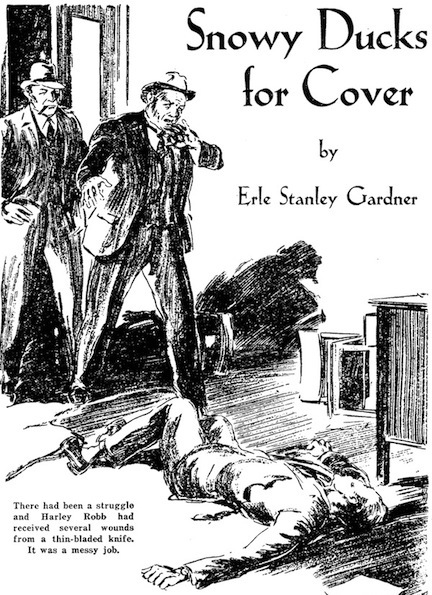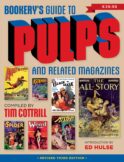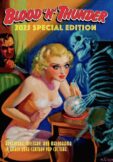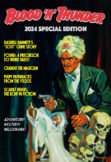EDitorial Comments
DIME DETECTIVE’s First Issue
In 1930 Harry Steeger and Harold S. Goldsmith launched their Popular Publications line of pulp magazines with four titles: Battle Aces, Detective Action Stories, Gang World, and Western Rangers. Popular’s initial offerings enjoyed varying degrees of success, but it wasn’t until the following year that the new company really hit pay dirt.
Newsstands across the nation displayed the first issue of Dime Detective on October 15, 1931. The William Reusswig cover portrayed a shadowy figure coming through a trap door, with a hook where his left hand should have been. Not terribly well executed, it nonetheless gave the new magazine a properly atmospheric send-off.
Dime Detective would become one of Popular’s two or three most successful pulps, with 274 issues published before its demise in mid-1953. At the beginning of its peak period (roughly 1934 to 1943) the magazine was published twice monthly.
It’s been said that Steeger intended from the first to make Dime Detective stiff competition for Black Mask, the highly regarded magazine credited with bringing the terse, hard-boiled writing style of Ernest Hemingway to pulp fiction. To this end he obtained fiction from the Mask’s most popular authors—Frederick Nebel, Carroll John Daly, and Erle Stanley Gardner—by offering them a penny a word more than they were getting from Mask editor Joseph “Cap” Shaw. But reading that first issue, as I did recently, it’s obvious that Steeger hedged his bets. Unlike Black Mask, which under Cap Shaw’s editorship totally eschewed the fanciful in crime fiction, Dime Detective in the beginning favored lead stories known to the trade as “mystery-horror.” Such yarns teased readers with seemingly supernatural elements that were explained away in the denouements. In 1931 mystery-horror was quite popular and would become even more so within a few years. By including stories of this type Steeger couldn’t be accused of going head to head with Black Mask. At least, not yet.
In a back-of-the-book department titled “How About It?”, which asked for reader feedback, the unnamed editor (reportedly Steeger himself, at that point) claimed that J. Allan Dunn agreed to write a story based on Reusswig’s cover, which had been submitted on a “spec” basis. The resulting novelette, “Shadow of the Vulture,” opened that first issue. Hardly one of Dunn’s better efforts, it describes the efforts of brilliant amateur detective Guy Livingstone to run to earth a sadistic murderer known as “The Vulture” for the giant, winged shadow he casts. The illusion of a man-sized bird of prey is furthered by the Vulture’s modus operandi: ripping open the torsos of his victims with what appear to be huge talons. Livingstone is supposed to be a brilliant Sherlockian sleuth, but his deductions are short on logic and rely upon mounds of circumstantial evidence.
The second story, Frederick Nebel’s “Death Alley,” introduces Steve Cardigan, manager of the Cosmos Detective Agency’s St. Louis branch. He’s a two-fisted private dick along the lines of Nebel’s Black Mask character Donahue, and his debut adventure hews closely to the Mask model of snappy dialogue and swift, violent action. The 10,00000-word caper begins with Cardigan determined to avenge the murder of his friend and fellow Cosmos operative Pat O’Hara, and it ends with a shootout that sends most characters to the morgue and Cardigan to the hospital. Nebel’s subsequent entries in this series are generally good and have the Black Mask stamp.
Erle Stanley Gardner’s “Snowy Ducks for Cover” introduces what was probably intended to be another Dime Detective series hero. But even though various characters constantly refer to Snowy Shane’s unorthodox methods of detection, he didn’t impress me as being particularly noteworthy. The yarn itself, involving the murder of a bank president about to be unmasked as an embezzler, struck me as routine. Gardner at this time was turning out much better stuff for both Black Mask and Detective Fiction Weekly, and this so-so story was likely placed in Dime Detective’s inaugural number just to get his name on the cover. It marked the first and last appearance of Snowy Shane, one of several mediocre series characters Gardner created for the magazine.
“The Pullman Murder,” a straightforward, fast-action, tough-as-nails novelette by T. T. Flynn, is not only the first issue’s longest story but possibly its most satisfying as well. Protagonist Bill Brady suddenly awakens from a deep sleep while in his Pullman berth. Someone has just tossed an alligator-skin Gladstone into his compartment. The bag is covered with fresh blood and contains thousands of dollars in well-used bills. Flynn’s story proceeds along classic mistaken-identity lines, with its everyman protagonist thought to be a Treasury agent in hot pursuit of counterfeiters. While cut to a familiar pattern, the yarn is fast-paced and loaded with gritty action.
Dime Detective’s first issue closes out with Edward Parrish Ware’s “The Devil’s Jackpot,” which follows Memphis-based private detective Jim Lenoir to Arkansas’s Black River country, where he’s pitted against a gang looking for a cache of priceless fresh-water pearls. Ware’s story is smoothly done and a bit tougher than his Detective Fiction Weekly tales of this period, but it’s nothing special.
Overall, I was somewhat disappointed in Volume One, Number One of Dime Detective. It’s clear Steeger had not yet decided how to slant the magazine, and the variable story quality suggests that the issue was thrown together in a hurry. Under the editorship of Ken White, Dime Detective eventually found its voice, so to speak, and became one of the top pulps of its kind.
6 thoughts on “DIME DETECTIVE’s First Issue”
Leave a Reply
Recent Posts
- Windy City Film Program: Day Two
- Windy City Pulp Show: Film Program
- Now Available: When Dracula Met Frankenstein
- Collectibles Section Update
- Mark Halegua (1953-2020), R.I.P.
Archives
- March 2023
- July 2021
- May 2021
- March 2020
- February 2020
- December 2019
- November 2019
- October 2019
- September 2019
- August 2019
- May 2019
- April 2019
- March 2019
- February 2019
- December 2018
- November 2018
- October 2018
- August 2018
- June 2018
- February 2018
- December 2017
- October 2017
- September 2017
- August 2017
- May 2017
- April 2017
- February 2017
- September 2016
- August 2016
- July 2016
- June 2016
- November 2015
- October 2015
- September 2015
- August 2015
- July 2015
- June 2015
- May 2015
- April 2015
- March 2015
- February 2015
- January 2015
- August 2014
- July 2014
- June 2014
- May 2014
- April 2014
- January 2014
- December 2013
- September 2013
- August 2013
- July 2013
- June 2013
- May 2013
- April 2013
- March 2013
- February 2013
- January 2013
- December 2012
- October 2012
- September 2012
- August 2012
- July 2012
- June 2012
- May 2012
Categories
- Birthday
- Blood 'n' Thunder
- Blood 'n' Thunder Presents
- Classic Pulp Reprints
- Collectibles For Sale
- Conventions
- Dime Novels
- Film Program
- Forgotten Classics of Pulp Fiction
- Movies
- Murania Press
- Pulp People
- PulpFest
- Pulps
- Reading Room
- Recently Read
- Serials
- Special Events
- Special Sale
- The Johnston McCulley Collection
- Uncategorized
- Upcoming Books
- Western Movies
- Windy City pulp convention
Dealers
Events
Publishers
Resources
- Coming Attractions
- Field Guide to Wild American Pulp Artists
- MagazineArt.Org
- Mystery*File
- ThePulp.Net






Even though you were disappointed in the quality of the stories, Ed, it was great to read your reviews of them. Unless (or until) somebody decides to reprint this issue, it’s as close as most of us will get to reading these tales ourselves.
Does anyone know why Carrol John Daly quit writing for BLACK MASK? Did he have a falling out with Shaw? Other authors continued to write for both DIME DETECTIVE and BLACK MASK, but Daly left the title until Shaw was replaced. Just askin’.
Joel, I don’t know that we can say for sure why Daly quit Black Mask, but we do know he was no favorite of Cap Shaw’s. And we know that he resented Shaw’s deification of Dashiell Hammett. It’s also significant that when Shaw was assembling his 1946 anthology of Black Mask stories for Simon & Schuster, Daly was pointedly omitted from the list of authors slated for representation. The idea that Shaw would leave Daly out while contemplating the inclusion of J. Paul Suter has always been mind-boggling to me. (Suter didn’t make the final cut, but still…) Moreover, he is said to have continued publishing Race Williams stories only because the magazine’s loyal readers demanded them.
Hi, Ed. I did not know that info regarding the story selections for the HARDBOILED OMNIBUS. Since my query, I realized that Daly’s writing changed especially after moving to DIME DETECTIVE. He padded the stories, and his attempts at building suspense by Race hash over every scenario preceding a confrontation stalls the narrative. A later story I read, under the editorship of Daisy Bacon was markedly better. When it came down to it, Daly left over money, getting much more per word from Popular Publications for better or for worse.
I also like T.T. Flynn. His detective pulp work has not received much notice but Jon Tuska has reprinted many of Flynn’s western novelets in over a dozen collections. I’d like to see a collection of the Mr. Maddox stories that Flynn wrote for DIME DETECTIVE.
Even better then the Mr.Maddox stories were the Mike and Trixie stories he did for Detective Fiction Weekly.Flynn is one of the underated pulp authors.In Dime Detective he also did two very short series,one about Jerry Prince and the other about Izzy O’Shea.Very good.